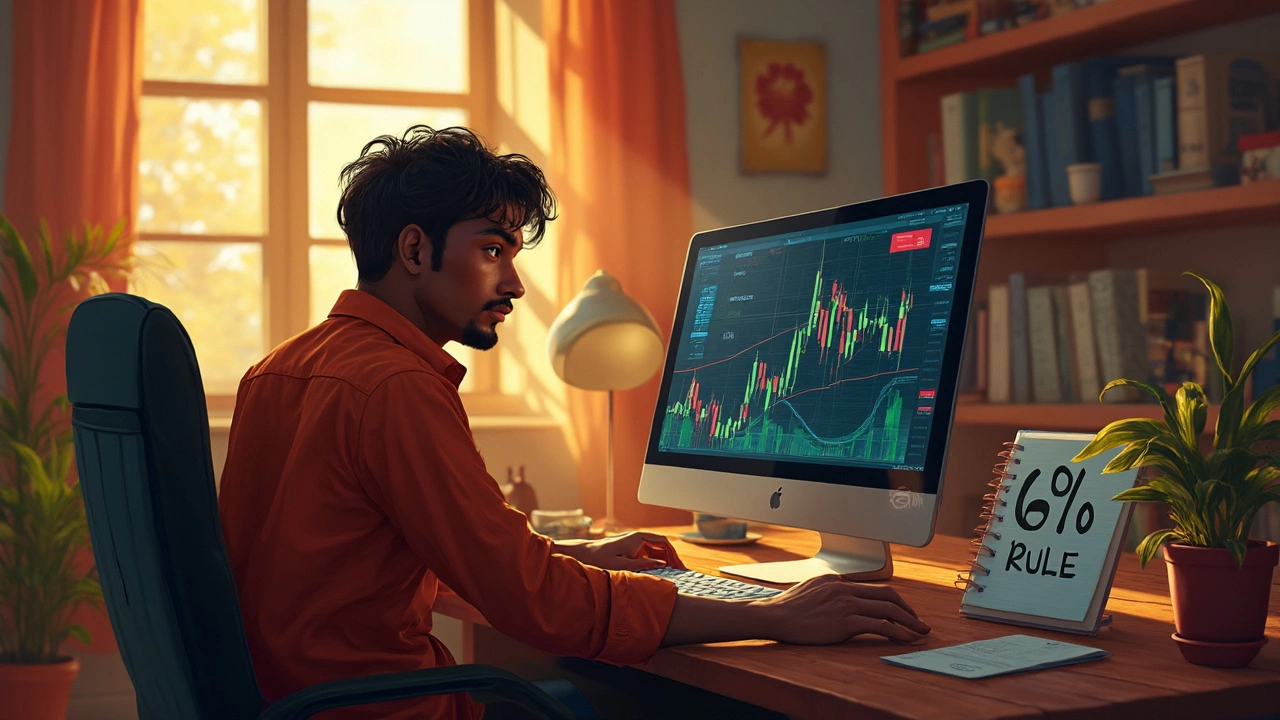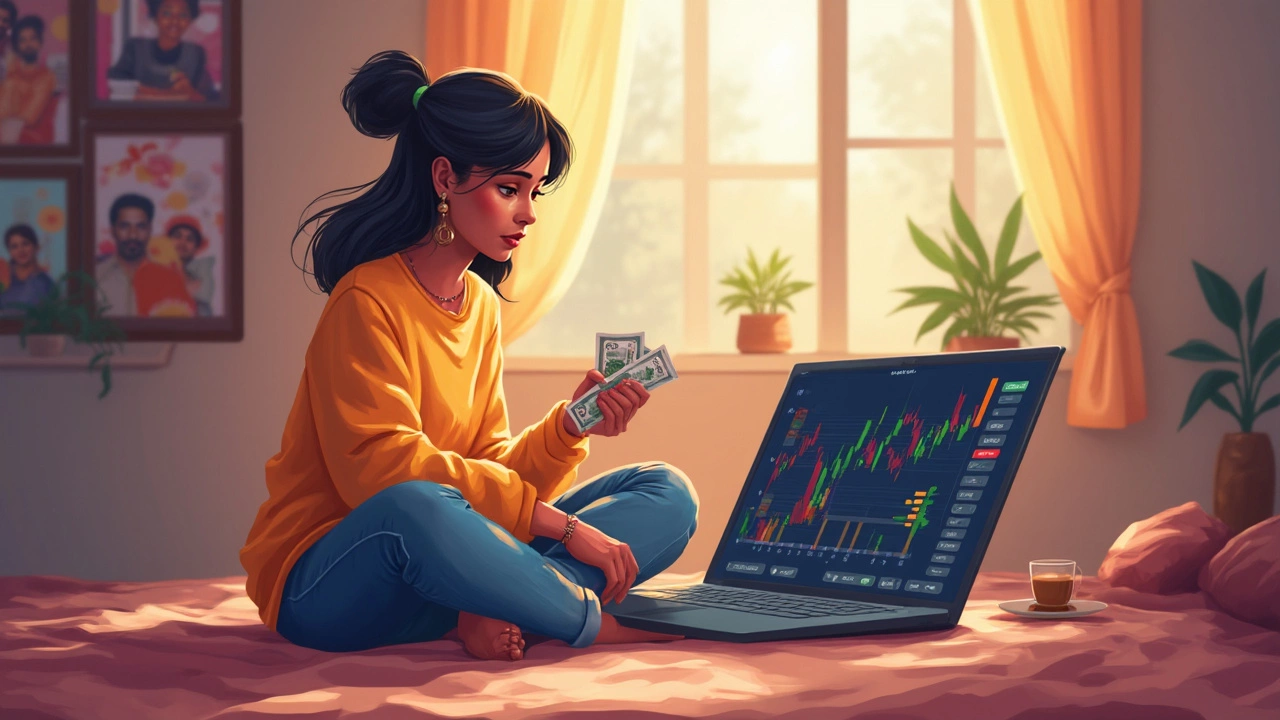Risk is the number one thing that wipes out day traders. Ever hear of the 6% day trade rule? If you haven’t, you might be one blown trade away from a painful lesson. The 6% rule is simple: you never risk more than 6% of your trading account in one day. That means if you start the day with $10,000, you stop trading for that day once you’re down $600—no "just one more try" or revenge trades to win it back.
The best traders I know have a strict limit, and it’s not because they’re timid. It’s because one bad day can wipe out weeks or months of steady wins. Setting this kind of boundary protects you from panic, overtrading, and the urge to double down when things go south. Trust me, everyone thinks they’ll stay calm until the red numbers hit.
- The 6% Rule Explained
- Why Risk Management Is Crucial
- How to Apply the Rule in Real Trades
- Common Mistakes and How to Avoid Them
- Expert Tips for Safer Day Trading
The 6% Rule Explained
The 6% rule is a simple but powerful concept in the world of day trading. Basically, it means you’ll never allow yourself to lose more than 6% of your entire account balance on any single day. So, if your trading account has $5,000 in it and things get rough, you walk away for the day if you’re down $300. No exceptions, no moving the goalposts.
Traders use this rule because it gives you a clear stop-loss for the day—kind of like an emergency brake. You’re not just protecting your cash, you’re also protecting your sanity. This rule doesn’t care why you’re losing—maybe your strategy isn’t working that day, maybe the market’s going nuts, or maybe you’re just having an off morning. The 6% line means you live to trade another day instead of spiraling into bigger losses.
Lots of pro traders and educators talk about the 6% rule (sometimes you’ll see 5% or even 2% for super conservative folks) as a sanity check, especially for beginners who aren’t used to the emotional roller coaster of losing trades. It’s like bumpers in bowling—sure, the pros might not need them, but if you’re just getting started, they can keep your account from crashing fast.
Here’s what following the 6% rule actually looks like in practice:
- Start each day knowing your total account balance.
- Multiply your balance by 0.06. That’s your max loss for the day.
- Set alerts with your broker, so if you hit that red limit, you’re locked out—or least reminded to stop.
- No "just one more trade" after passing the limit. The market will be there tomorrow.
Here’s a quick table showing what the 6% rule looks like based on different account sizes:
| Account Size | 6% Daily Limit |
|---|---|
| $1,000 | $60 |
| $5,000 | $300 |
| $10,000 | $600 |
| $25,000 | $1,500 |
It’s not about limiting your upside—it’s about making sure a single rotten day doesn’t wipe you out. Most traders who blow up accounts aren’t following this rule. So, build the habit. Your future self (and your bank account) will thank you for it.
Why Risk Management Is Crucial
A lot of new traders focus on finding the “perfect” strategy or that one magic indicator. But none of that matters if your risk management stinks. Managing risk is the only thing that keeps day traders in the game after a string of losing trades—or even a single nasty loss.
The shocking reality: over 70% of day traders reportedly lose money and quit within their first year. Most of the time, it’s because they let one or two bad trades spiral out of control. No one plans to blow up their account, but it happens fast if you aren’t setting limits like the 6% rule.
Let’s get real for a second. The stock market can turn ugly in minutes. News drops, algorithms trigger wild swings, or a glitch freezes your broker. If you haven’t set a hard cap on daily losses, you’re basically gambling. 6% rule forces you to step back when it’s just not your day, so you live to trade again.
- It builds discipline, which is way more valuable than hot stock tips.
- It cuts down on emotional decisions, like chasing losses or doubling up “just to get even.”
- It helps you survive rough patches and find your edge over time.
If you love numbers, check this out:
| Account Size | Max Daily Loss (6%) |
|---|---|
| $1,000 | $60 |
| $5,000 | $300 |
| $10,000 | $600 |
| $25,000 | $1,500 |
Keep these numbers in mind the next time you’re tempted to push your luck. Good risk management isn’t glamorous, but it’s the difference between staying in the game or cashing out early with nothing but lessons learned.

How to Apply the Rule in Real Trades
First, calculate your total account value before starting your trading day. Say you’ve got $5,000 in your account—your max daily loss under the 6% rule is $300. This isn’t about the size of each trade, but your total drawdown for the whole trading session. Once you’re down $300, it’s time to close the laptop or log out for the day, even if you feel like you’ll just get one more win.
Now, break that loss limit down per trade. Plenty of pros only risk 1-2% of their account per trade. That way, a few bad trades won’t put you straight at your 6% stop. Here’s how that might look in practice:
- With $5,000, your per-trade risk at 2% is $100. If you lose three trades in a row, you’re at $300—done for the day.
- It’s smart to set alerts or even automated stops on your platform to keep you honest. Most trading apps let you lock a daily loss limit so you can’t break your own rule.
Want to be more cautious? Some traders keep their loss limits even tighter. At earn2trade, study data shows that traders with hard daily stops (like 4-6%) last twice as long in funded accounts compared to those who don’t stick to a limit.
Remember, it’s not just about sticking to the rule on red days. If you’re up $200 and then lose $300, you’re still done for the day when you hit the $300 loss mark—even if that means you end at a net loss of $100 for the day. Consistency is key for long-term survival in this game.
| Account Balance | 6% Max Loss | Max $ Per Trade (2%) |
|---|---|---|
| $2,000 | $120 | $40 |
| $5,000 | $300 | $100 |
| $10,000 | $600 | $200 |
The point is to avoid blowing up your account in one emotional streak. No one trade is worth breaking your risk plan. A strict 6% cap gives you another shot tomorrow—and that’s where the real edge is for small and large traders alike.
Common Mistakes and How to Avoid Them
Even though the 6% rule sounds simple, traders run into the same traps over and over. New traders, especially, can slip because they ignore the rule or don’t realize how fast losses add up. So, what goes wrong most often?
- Ignoring Your Daily Loss Limit: Some folks blow past their 6% loss, promising themselves they’ll "make it back." This is usually how an account gets drained in a day or two. Treat your limit like a hard stop—when you hit it, walk away and come back the next day.
- Poor Position Sizing: Not knowing how many shares you should buy or sell leads to risking way too much on one trade. Before you enter a trade, figure out exactly how much you could lose. If losing means you hit your daily limit in one shot, your position is way too big.
- Averaging Down on Losers: Chasing after a losing position by adding more trades only makes things worse. It’s tempting to see a stock dip and think, "If I double down, I’ll break even." Most of the time, you just lock in a bigger loss.
- Overtrading: After a few losses, some traders get desperate and start making trades just to make back money. This is usually when mistakes pile up. The market isn’t a slot machine, and you can’t force a win.
- Not Tracking Trades: If you aren’t tracking your wins and losses, it’s easy to forget how fast small losses add up to that 6%. A trading log or simple spreadsheet keeps you honest and helps you spot patterns in your mistakes.
Want the numbers? According to a FINRA report, over 70% of day traders lose money each quarter, and a lot of that is due to ignoring risk rules like this one.
So how do you dodge these mess-ups?
- Set hard stop-losses in your trading app so temptation never gets a say.
- Limit your trading screen time when things aren’t going your way. Even pros force themselves to take breaks after hitting limits.
- Use alerts that warn you when you’re close to max loss.
- Size your positions so you could survive a losing streak without wiping out your account.
- Keep a written log. Review it every week to see what’s really working and what moves to ditch.
And remember, the 6% rule isn’t just a tip. It’s there to save you from yourself when emotions start running the show.

Expert Tips for Safer Day Trading
Trading smart isn’t just about picking hot stocks; it’s about protecting your account so you can play the game tomorrow. Here’s what seasoned traders always keep in mind to avoid the usual blow-ups.
- Stick to your plan: Write down your rules before you trade, not during. When emotions run high, your brain will want to improvise—that’s exactly how you break the 6% rule and end up regretting it.
- Use stop-loss orders: Waiting to "feel" when to cut a losing trade is dangerous. Set specific prices that will get you out automatically if things go south. This takes the guesswork out of protecting your cash.
- Keep your position size small: No single trade should ever threaten your account. If you risk less per trade, you’ll have room to make smart decisions—even if you hit a losing streak.
- Limit the number of trades: Quality always beats quantity in day trading. Don’t fall into the trap of overtrading to "make back" losses. Track each trade and focus on setups that fit your system.
- Review your trades every week: Write down what worked, what didn’t, and why. Patterns will pop out if you’re honest. Many pros keep a trade journal—sounds boring, but it can save you thousands.
Here’s a quick look at what happens to a $10,000 account if you stick to the 6% rule versus no limit at all:
| Scenario | Loss in One Bad Day | Account Balance |
|---|---|---|
| 6% Rule Applied | $600 | $9,400 |
| No Limit | $2,000 (20% drop) | $8,000 |
Getting back from a huge drop like 20% takes a lot more winning trades than you’d think. That’s why risk management isn’t optional—it’s the edge almost nobody brags about but every survivor uses.
Finally, never feel pressured to trade every day. The market isn’t going anywhere, and the best setups don’t pop up every five minutes. Sitting on your hands can be a strategy too.
In the end, the 6% rule is just one tool, but following rules like these means you get to keep trading week after week—without the stress of a blown account.



